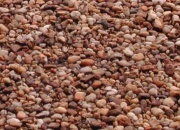Difference between revisions of "Gravel"
Jump to navigation
Jump to search
(username removed) |
|||
| Line 2: | Line 2: | ||
== Description == | == Description == | ||
| − | A general term used for stone aggregate ranging in size from 4 mm to 64 centimeters. Natural gravel deposits are found are found near rivers or beaches. The stones typically have rounded edges due to abrasion and weathering. [ | + | A general term used for stone aggregate ranging in size from 4 mm to 64 centimeters. Natural gravel deposits are found are found near rivers or beaches. The stones typically have rounded edges due to abrasion and weathering. [[Clay]] accumulations in the gravel can form a cemented stone called a [[conglomerate]]. |
== Authority == | == Authority == | ||
Revision as of 09:06, 16 January 2014
Description
A general term used for stone aggregate ranging in size from 4 mm to 64 centimeters. Natural gravel deposits are found are found near rivers or beaches. The stones typically have rounded edges due to abrasion and weathering. Clay accumulations in the gravel can form a cemented stone called a Conglomerate.
Authority
- External source or communication Comment: Submitted information: Fred Gamble, October 2007
- The American Heritage Dictionary or Encarta, via Microsoft Bookshelf 98, Microsoft Corp., 1998
- Encyclopedia Britannica, http://www.britannica.com Comment: "Gravel." Encyclopædia Britannica. 2004. Encyclopædia Britannica Premium Service. 13 May 2004 .
